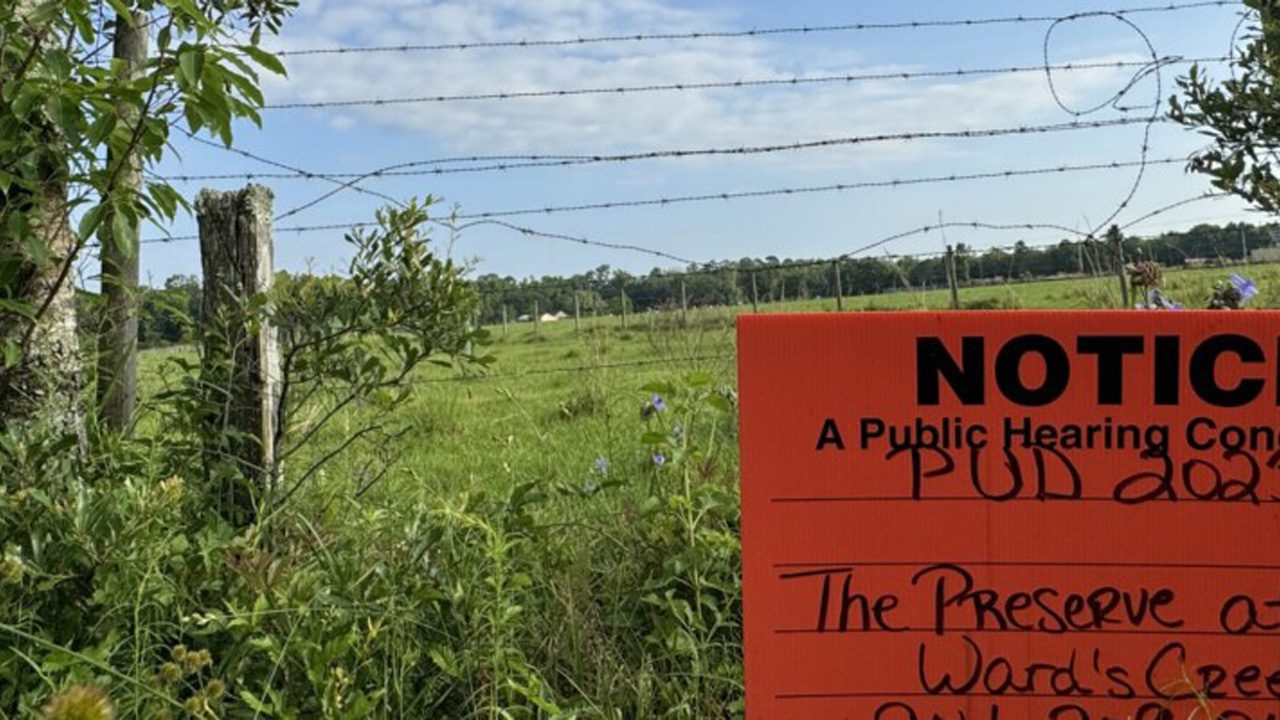Workforce housing project rejected in St. Johns County
Jax Today | By Noah Hertz | September 3, 2024
Citing traffic concerns in the existing neighborhoods west of St. Augustine Shores, the St. Johns County Commission on Tuesday denied the proposed Osceola Lakes development. The project would have led to the construction of more than 600 homes on 145 acres of land.
The project called for up to 640 single-family homes, duplexes and townhomes between Wildwood Drive and Watson Road. Pitched as a workforce housing project, the development would have included roughly 200 residences capped at — using this year’s numbers — $267,000 for five years.
During roughly two hours of comments from the public, supporters and opponents of the project stated their cases to the County Commission.
Opponents urged the county to recognize the existing traffic issues in the area — the difficulty of making left turns onto two-lane roads and the lack of shoulders, to name a few — and to keep such a dense development far away from what some characterized as a sleepy neighborhood.
Supporters of the Osceola Lakes development repeatedly pointed out that high housing costs in St. Johns County have priced out essential workers like firefighters, teachers and nurses, making living near where you work unattainable.
One supporter of the project was Robert Regan. He said he never thought he’d be speaking in front of the County Commission in favor of “more development in Florida.” But as he finishes up preparations to become a firefighter, and with one child at home and another on the way, he said people like him who want to move from Duval County to St. Johns need more options.
As a lifelong Florida resident, Regan said he’s familiar with the concerns, but that it isn’t that simple.
“Florida’s always been like this since the 1920s — people coming in, developing, making homes. I’m from here, born here,” he said. “All these people living in houses that are half a million dollars, got all this equity, it’s kind of unfair to be like, ‘OK, we’re going to shut this down because we’re good, but they can go somewhere else.”
But opponents, many of whom said they are proponents of workforce housing, said the project just didn’t make sense where it was proposed.
One such person, Rob Gober, who lives nearby where Osceola Lakes would have been built, said people just starting out in their careers shouldn’t expect to be able to buy a home. Starting his career as a law enforcement officer, he couldn’t.
His neighborhood already has firefighters, teachers and others, he said, and he doesn’t believe that his friends at the St. Johns County Sheriff’s Office would be able to afford to buy a home in Osceola Lakes.
If the developer really wanted to support workforce housing, Gober said, they’d restrict the prices of more than just a third of the proposed homes.
“If they really want to build it, they should build all the homes in there workforce, then nobody would be against it,” he said. “Just not 640. It’s not fair to that community or the schools.”
Developers argue that it’s dense neighborhoods like this one that cover the costs of building cheaper workforce housing.
A representative for Osceola Lakes said just that: “We can’t save enough 2-by-4s to build the affordable housing without the density.”
Had the project been approved, the developer — who was not identified in the documents beyond the name of a blind trust — would have funded improvements to nearby U.S. 1 to the tune of $17 million, as well as other road improvements. The nearby elementary and middle schools could support more capacity, representatives for the developer noted, but the high school could not, so they would be pitching in another $600,000 to make up for potential new students.
Ultimately, while members of the County Commission recognized the need for more housing that would keep teachers and other essential workers from commuting from nearby counties, they couldn’t support the project near St. Augustine Shores.
“While I think that the workforce component is much needed, and the contributions from the developer — the hard dollars — are great,” St. Johns County Commission Chair Sarah Arnold said, “from what I’ve heard today, it’s still not enough to offset my concerns of infrastructure, of the school capacity, of the drainage, to concerns with the road.”
Only one commissioner voted in favor of the project: County Commissioner Roy Alaimo.
More people need to be able to live where they work, he said, and he would not let the perfect be the enemy of the good.






